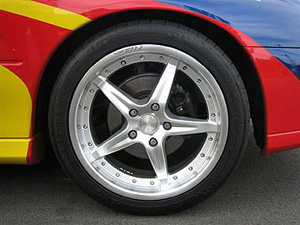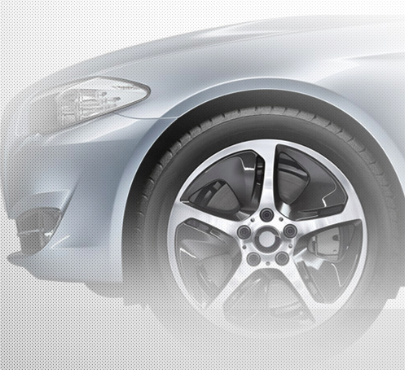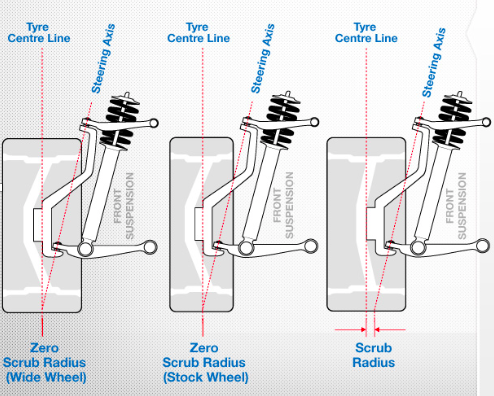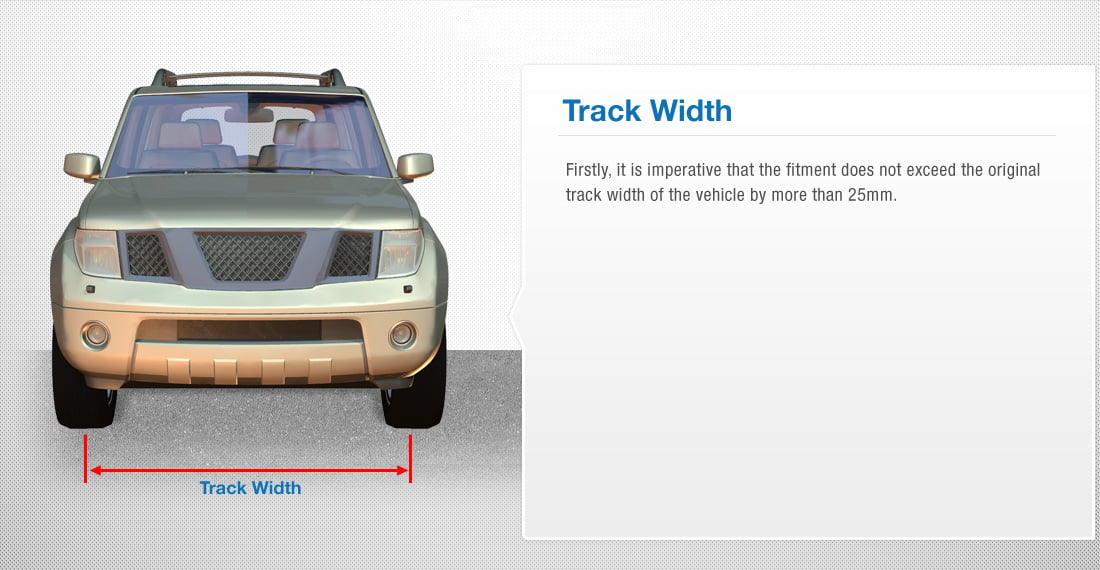
Wheels up to 26mm wider than the largest optional wheel recommended by the vehicle manufacturer for the vehicle can be fitted without the need to notify the RTA. The overall diameter of the wheel and tyre combination must be no more than 15mm over the largest diameter wheel and tyre combination specified for the vehicle and not more than 15mm below the smallest diameter wheel and tyre combination specified for the vehicle.
When fitting a larger wheel & tyre fitment the combination of the replacement fitted unit MUST stay within the mudguard. Also when viewed directly from the top of the mudguard to the ground, with the tyre & wheel unit facing in a straight ahead position, the tyre & wheel MUST not be visible.
Influence of Smaller Offsets to Standard Fitment

If the new wheel is wider than the wheel fitted originally by the vehicle supplier, clearance could be reduced between the vehicle's bodywork and or suspension.
There is obviously a limit to how much of a width change you can make without adversely influencing legal requirements, which require the wheel and tyre unit to be covered by the mudguard and not protrude from the vehicle's bodywork.
Smaller offsets will create a scrub radius, which may affect the handling of the car, but there are a number of reasons why you may need to choose a smaller offset, which are in the next slide.

- To compensate for a wider wheel: A wider wheel with an identical scrub radius as the original wheel, will be positioned closer to the suspension components. If the wheel is too wide, it will not fit. To compensate, you would choose a smaller offset to move the wheel away from the suspension or inner bodywork.
- A smaller offset than the original will set the wheels outward, so that the stance of the car becomes wider and stability is increased. In some applications, the benefits of this stability are greater than the drawbacks of the scrub radius change and the driver may make this compromise.
- Smaller offsets than original fitments, move the wheels outward so they have a tendency to fill out the wheel to provide improved looks. Vehicles set up for show, more than performance, will often choose a lower offset wheel. If the offset is too small the sidewall will rub the inside of the external bodywork.

A wheel fitment refers to the wheel fits within the wheel well and under the fenders. The wheel and tyre combination must fit your specific vehicle to allow for appropriate handling and performance capabilities.
Your local Jax Tyres & Auto professional is able to perform a wheel fitment for you. We’ll mount and balance the correct wheel and tyre combination for your particular make and model vehicle.
Knowing whether your new wheel will fit your vehicle can be a bit tricky. Jax Tyres & Auto are experts in their field and will help you find the right wheel for you. There are four critical elements:
- Bolt Pattern: Consists of the number of wheel studs and the measurement between the two furthest bolts. For example, if your bolt pattern was 5X100, ‘5’ stands for five bolts on the wheel; 100mm for the length between the two furthest bolt holes.
- Backspace: Measure from the mounting surface of the wheel to the back of the wheel in inches. The measurement will show you the maximum distance the wheel can go back without rubbing any other vehicle components under the fender.
- Offset: The offset is measured from the centreline of the mounting pad and calculated in positive (+) or negative (-) millimetres (mm).
- Plus sizing or upsizing: If the diameter of your wheel increases, you must reduce the aspect ratio to maintain the same overall diameter of your wheel-to-tyre setup. Reducing the aspect ratio maintains enough clearance from your other vehicle components.
Wheel offset is one of the most significant factors when determining whether your wheel will fit your specific vehicle. Getting the wrong offset when replacing your wheels risks damaging the replacement wheels and tyres as well as the suspension components.
- Too much positive offset: It will push the wheel farther in towards the suspension. Wheels set too far inwards can cause rubbing against your suspension, damage the inner wheel attachments and cause tyre rub. If not fitted properly, you’re in danger of a blowout.
- Too much negative offset: Your wheels can protrude too far out. Wheels pushed too far outwards can contribute to poor handling due to additional stresses on the suspension components.
If done incorrectly, it can put the driver at serious risk of a blowout. Check-in with your local Jax Tyres & Auto to find the right wheel for your car.
Having a negative offset on any width wheel is generally considered an aggressive offset.
A negative offset causes the wheel to push outwards. A more aggressive wheel fitment will give your car a much wider stance.
A wheel poke or stance is when the wheel and tyre stick outside of your fender. This is usually caused by changing your wheel to a negative offset, or moving to zero offset if your wheels are usually set as positive.
It's illegal for your tyres or wheels to stick out past your wheel arch in Australia.
Each state sets limitations to the changes that you can make to your vehicle's wheel track. Your wheel track is the distance between two wheels that sit side-by-side. The wheel track is affected when you change your wheels offset.
See your JAX Tyres & Auto wheel specialist for the best advice on all performance and safety aspects.

